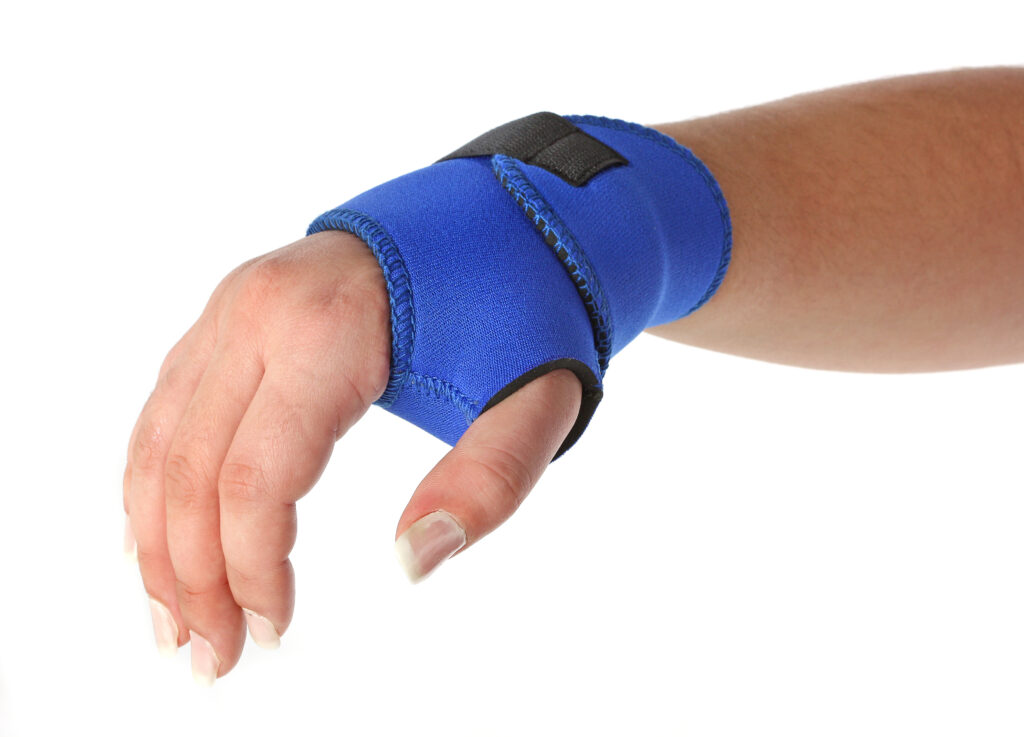Carpal Tunnel Syndrome (CTS) is a condition that causes pain, numbness and tingling in the hands. Self-care for CTS can be divided into two categories: lifestyle changes and physical therapy. Lifestyle changes include avoiding activities that may put stress on the wrists such as repetitive motions or gripping items too tightly.
A wrist brace can also be worn to help keep the wrists from bending too far backwards or forwards while typing or using tools. Physical therapy may involve exercises designed to stretch and strengthen the hands, wrists, elbow, shoulders and neck muscles. Hot/cold packs and ultrasound therapies can also provide relief from discomfort caused by CTS symptoms.
It’s important to discuss treatment options with your doctor as some treatments are more effective than others depending on an individual’s particular case of CTS.
Carpal tunnel syndrome can be a debilitating condition, but with proper self-care techniques it is possible to reduce the symptoms and improve hand function. Some of the key self-care measures include avoiding activities that put strain on your wrists, using ergonomic tools such as mouse pads and keyboards to reduce stress on your hands, stretching regularly, taking regular breaks from computer work, and using cold or hot compresses to relieve pain. Additionally, wearing a wrist brace at night can help keep your wrists in a neutral position while you sleep.
If these strategies do not provide relief for carpal tunnel symptoms then consulting with a doctor should be considered for further treatment options.
Can Carpal Tunnel Syndrome Be Treated Naturally?
Yes, carpal tunnel syndrome can be treated naturally. There are many different treatment options available that do not involve surgery or medications. The most common natural treatments for carpal tunnel syndrome include stretching and strengthening exercises to improve flexibility and strength of the muscles in the wrist and forearm; wearing a splint to keep your wrist in a neutral position while you sleep; using ice packs or warm compresses on your wrists to reduce swelling; avoiding activities that may aggravate symptoms such as typing, carrying heavy objects, or other activities involving repetitive motions of the hand or forearm; taking breaks from any repetitive tasks you may need to perform throughout the day; acupuncture which helps release tension around nerves in the area affected by CTS; yoga which helps increase strength and mobility while reducing stress levels associated with CTS pain; massage therapy which increases blood flow and reduces muscle tension in areas affected by CTS.
Additionally, some people have had success with alternative remedies such as chiropractic care, herbal supplements (such as ginger root), dietary changes (reducing sugar intake), vitamin B6 supplementation, essential oils like lavender oil applied topically on painful areas, and even cutting down caffeine consumption. With so many natural treatments available it is possible for those suffering from carpal tunnel syndrome to find relief without resorting to invasive measures such as surgery or medications.
Can Carpal Tunnel Be Fixed at Home?
Carpal tunnel syndrome is a condition that affects the hand and wrist. It can cause numbness, tingling, pain, and weakness in your hand and wrist. This condition can be caused by repetitive movements of the hands or wrists such as typing on a keyboard or using tools for long periods of time.
While there are many treatments available for carpal tunnel syndrome, including medications, physical therapy, and surgical procedures, some people prefer to treat their carpal tunnel syndrome at home. Home remedies include stretches to relieve pressure on the nerves in your arms; wearing an arm splint to keep your wrist straight while you sleep; avoiding activities that put strain on your wrists such as typing or playing video games; massaging affected areas with ice packs; taking breaks throughout the day from any strenuous activity involving your hands/wrists; eating foods high in B vitamins which are known to reduce inflammation; yoga poses specifically designed to stretch out tight muscles around the elbow joint area and finally meditation which helps promote relaxation of both body and mind leading to less stress overall. With commitment these methods may help reduce symptoms associated with carpal tunnel syndrome but it’s important to know they aren’t intended as replacements for medical advice from trained professionals such as doctors or physical therapists who can provide more specific guidance tailored individual needs.
What Should You Not Do With Carpal Tunnel?
When it comes to carpal tunnel, prevention is key! While there are a few ways to help prevent or manage the condition, there are also certain activities that should be avoided in order to minimize the risk of furthering the pain and discomfort associated with carpal tunnel syndrome. Here’s what you should not do if you’re suffering from carpal tunnel:
Avoid repetitive movements – Repetitive movement of your wrist can put pressure on the median nerve which runs through your arm into your hand. This can cause swelling around tendons leading to further discomfort so try not to perform any activity for long periods of time that involves making similar motions over and over again.
Don’t rest on your wrists- Lying down or resting with heavy objects (like textbooks) on top of your wrist could lead to more inflammation.
Instead, support yourself while sitting by propping up forearms and elbows on pillows or cushions instead.
Limit typing- If possible, limit typing as much as possible because it puts stress on already inflamed nerves in the wrists. If needed, take frequent breaks throughout working hours and alternate between hands when doing tasks such as using a mouse or keyboard.
You may even want to consider investing in an ergonomic keyboard if necessary!
Lastly, make sure that you wear splints at night – Wearing a splint while sleeping helps keep wrists straight during this period when muscles are relaxed and most vulnerable; this will help reduce pressure placed on nerves within them.
What are the Three Stages of Carpal Tunnel?
Carpal tunnel syndrome is a common condition that affects people’s hands and arms. It occurs when the median nerve, which runs from your forearm to your hand, becomes compressed. The three stages of carpal tunnel can be divided into mild, moderate, and severe.
During the mild stage, symptoms may include tingling in the fingers or hand as well as numbness or pain in one or both hands. As the condition progresses to more advanced stages such as moderate or severe cases, other symptoms like weakness in the hands and wrists can begin to occur. In addition to these physical signs of carpal tunnel syndrome there may also be emotional distress associated with this condition due to limited mobility and chronic pain levels impacting daily life activities.
Treatment typically focuses on reducing pressure on the median nerve by wearing splints at night or while performing repetitive tasks throughout the day; occupational therapy for stretching exercises; medications like non-steroidal anti-inflammatory drugs (NSAIDs) , steroids injections for inflammation reduction; surgery if necessary; lifestyle modifications including ergonomic changes such as using a wrist rest while typing at workstations ; avoiding activities known to exacerbate symptoms ; working within one’s limits when engaging in strenuous activity ; maintaining good posture habits during computer use; wearing supportive gloves during lifting heavy objects; applying ice packs after prolonged periods of working with tools or small parts .

Credit: www.healthline.com
Carpal Tunnel Syndrome Ice Packs
Carpal tunnel syndrome is a painful condition caused by compression of the median nerve in your wrist. Ice packs are an effective and non-invasive way to help reduce inflammation, pain, and swelling associated with carpal tunnel syndrome. To use them effectively, you should apply the ice pack for 15 minutes at a time several times each day.
When using an ice pack be sure to place a cloth between the skin and the cold source to prevent frostbite or other tissue damage from occurring.
How I Cured My Carpal Tunnel Naturally
It is possible to heal carpal tunnel syndrome naturally! After experiencing symptoms of pain, numbness and tingling in my hands for months, I decided to take matters into my own hands. By making lifestyle changes such as reducing stress levels, stretching regularly and strengthening the muscles in my arms and wrists, I was able to completely cure my carpal tunnel without any medication or surgery.
It took a few weeks before I could feel the difference but it was definitely worth it!
Two Conditions That are Often Misdiagnosed As Carpal Tunnel Syndrome
Carpal tunnel syndrome (CTS) is a painful and often disabling condition that affects the hand and wrist. However, there are two other conditions which can be misdiagnosed as CTS: tendonitis of the wrist or forearm and ulnar nerve entrapment at the elbow. Tendonitis occurs when tendons become swollen due to overuse or injury, while ulnar nerve entrapment refers to compression of the ulnar nerve at the elbow.
Both of these conditions cause symptoms similar to CTS such as pain, tingling, numbness in your fingers, weakness in your hands and wrists, but require different treatments than traditional carpal tunnel treatment methods.
Best Anti-Inflammatory for Carpal Tunnel Syndrome
Carpal tunnel syndrome is a painful condition that occurs when the median nerve in your wrist becomes compressed. To help alleviate symptoms, an anti-inflammatory diet can be beneficial. Foods high in omega-3 fatty acids such as oily fish, flaxseeds, and walnuts may help reduce inflammation and relieve pain associated with carpal tunnel syndrome.
Additionally, natural supplements like turmeric have been shown to ease inflammation and reduce pain from carpal tunnel syndrome.
Carpal Tunnel Relief Exercises
Carpal tunnel relief exercises can be a great way to reduce the pain and discomfort caused by carpal tunnel syndrome. Stretching, strengthening, and range of motion exercises are all important components of an effective carpal tunnel relief exercise program. Exercises should focus on stretching the wrists, hands, forearms and upper arms to increase flexibility in these areas and reduce pressure on the median nerve.
Additionally, strengthening exercises for the muscles surrounding the wrist can help improve posture as well as provide better support for your wrist when typing or using a mouse. When done regularly, carpal tunnel relief exercises can help alleviate symptoms associated with this condition so you can get back to enjoying life without discomfort!
How to Relieve Carpal Tunnel Pain at Night
If you suffer from carpal tunnel pain, especially at night, there are some steps you can take to help reduce the discomfort. Try wearing a wrist splint when sleeping and throughout the day if possible; this will keep your wrists in an extended position which will help alleviate pressure on the median nerve. Additionally, try soaking your hands in warm water for several minutes before bed or applying cold packs to help reduce inflammation.
Regularly stretching and massaging your arms and wrists can also be beneficial in relieving tension as well as increasing blood flow to the area. Finally, consider making modifications to your sleep environment – such as using a thicker pillow between your arms – that may provide additional comfort while you rest.
Carpal Tunnel Syndrome Therapies
Carpal Tunnel Syndrome (CTS) is a common condition that can cause pain, numbness, and tingling in the hand and wrist. Treatment of CTS may involve lifestyle changes such as wearing a brace or splint at night, taking frequent breaks from activities that put strain on the wrists, exercising regularly to keep joints flexible, and avoiding repetitive motions. Other treatments include physical therapy exercises to reduce inflammation around the carpal tunnel area as well as medications such as anti-inflammatory drugs or corticosteroids injected into the carpal tunnel itself.
In extreme cases where other treatments fail to provide relief from symptoms, surgery may be recommended by your doctor to widen the carpal tunnel space and relieve pressure on the median nerve.
What is the Fastest Way to Get Rid of Carpal Tunnel
The fastest way to get rid of carpal tunnel is by treating the underlying cause. This may include rest, immobilizing your wrist with a brace or splint, physical therapy, and possibly steroid injections. Additionally, ergonomic modifications such as adjusting how you type on your keyboard can help reduce strain on the wrists and relieve symptoms of carpal tunnel syndrome.
Conclusion
Carpal Tunnel Syndrome can be a debilitating condition, but with proper self-care and lifestyle modifications it is possible to manage the symptoms. Self-care strategies such as taking frequent breaks from repetitive activities, stretching regularly, keeping wrists in neutral positions when typing or using phones, and implementing ergonomic principles into everyday activities can help reduce stress on the median nerve. Additionally, medications and surgery may also be necessary for managing specific cases of carpal tunnel syndrome.
Ultimately, when properly managed through a combination of self-care methods and medical treatments if needed, those living with carpal tunnel syndrome can live an active life without pain or discomfort.






